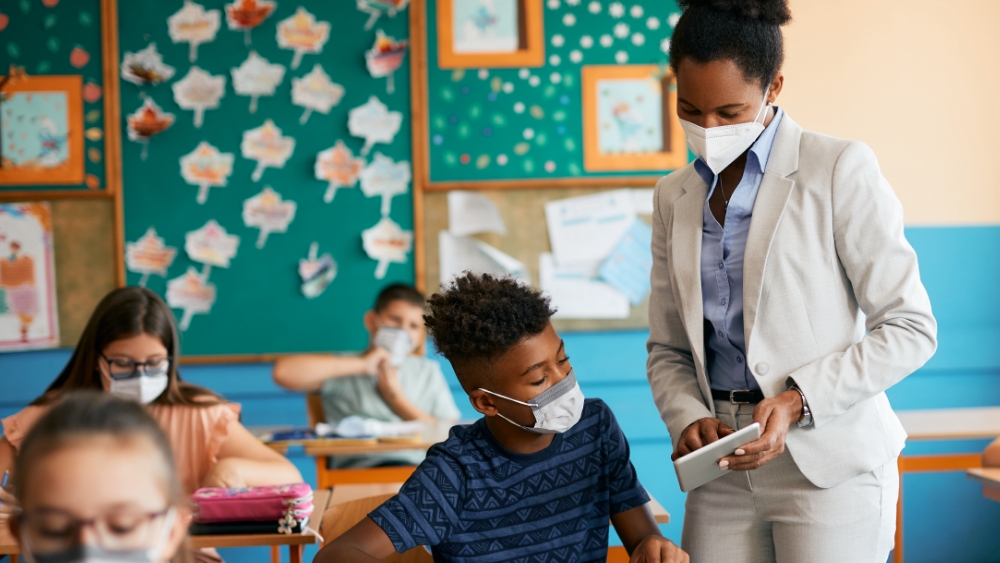
In a study of 61 school districts, researchers found that schools with mask mandates had far fewer cases of COVID-19 than those with optional or partial masking policies.

In a study of 61 school districts, researchers found that schools with mask mandates had far fewer cases of COVID-19 than those with optional or partial masking policies.
What you need to know
SARS-CoV-2, the virus that causes COVID-19, spreads through the air in tiny droplets released when we talk, sneeze, and cough. Research has shown that having people cover noses and mouths with masks reduces transmission of those particles. Since the early stages of the pandemic, mask mandates have been used as a safety measure in public spaces such as schools.
Researchers supported by the Rapid Acceleration of Diagnostics-Underserved Populations (RADx-UP™) program and the Eunice Kennedy Shriver National Institute of Child Health and Human Development have found that transmission of SARS-CoV-2 was far lower in schools that required masks than in schools that did not.
What did the researchers do?
Schools have adopted a wide variety of masking policies to combat the spread of COVID-19, and researchers wanted to know which masking policies have been most effective.
To find out, they gathered health department data on 61 school districts in nine states from several regions of the country from July to December 2021 during the Delta surge. This data accounted for more than 1.1 million K–12 students and 157,000 staff members. Researchers gathered information on whether the districts made mask wearing mandatory, made it optional, or had a partial masking policy (defined as one that changed during the study or had different requirements for different grade levels). The data included the number of COVID-19 cases found among the people included in the study and whether children or staff members got the infection at school.
In all, more than 40,000 cases of COVID-19 were attributed to community spread. More than 3,000 secondary infections were determined to have come from schools. Districts with mandatory masking policies had significantly fewer school-acquired COVID-19 cases compared with schools with optional masking policies.
The researchers predicted that for every 100 cases of COVID-19 attributed to community spread, 26.4 additional cases would result from schools having optional masking policies, while only 7.3 additional cases would result from schools that had mandatory masking — a 72% difference.
Why is this research important?
This research took place during the spread of the Delta variant from July through December of 2021. Although future research will include cases caused by newer variants like Omicron, the study shows that masking has been and is still one important strategy to reduce the spread of COVID-19 in schools and in other public spaces.
Where can I go to learn more?
-
An NIH press release gives more details about the study.
-
This edition of NIH News in Health offers tips on the proper use of masks, a list of helpful links, and links to scientific publications on the effectiveness of masks.
-
The Centers for Disease Control and Prevention (CDC) offers a locator to enter your ZIP code and find a location near you that offers free masks (N95 respirators).
Sources
Boutzoukas, A. E., Zimmerman, K. O., Inkelas, M., Brookhart, M. A., Benjamin, D. K., Sr., Butteris, S., Koval, S., DeMuri, G. P., Manuel, V. G., Smith, M. J., McGann, K. A., Kalu, I. C., Weber, D. J., Falk, A., Shane, A. L., Schuster, J. E., Goldman, J. L., Hickerson, J., Benjamin, V., … Benjamin, D. K., Jr. (2022). School masking policies and secondary SARS-CoV-2 transmission. Pediatrics, 10.1542/peds.2022-056687. Advance online publication. https://doi.org/10.1542/peds.2022-056687

News and Stories
Read stories about the efforts underway to prevent, detect, and treat COVID-19 and its effects on our health.
 An official website of the United States government
An official website of the United States government

